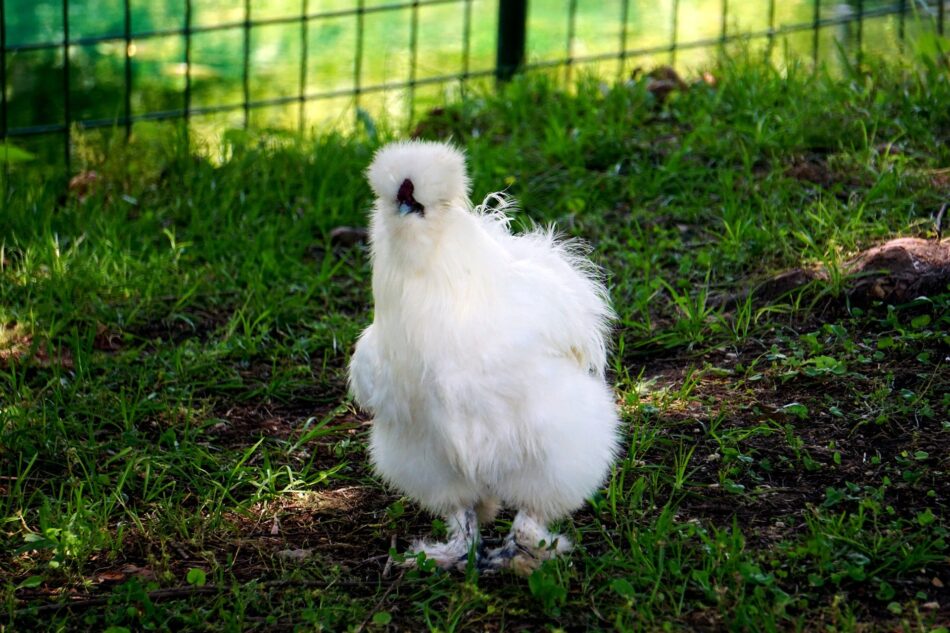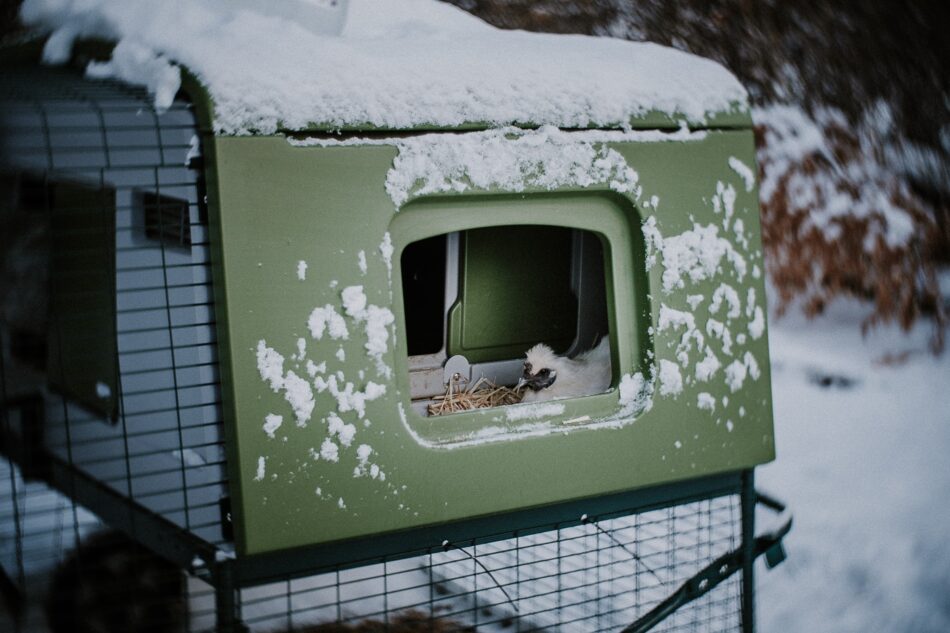Silkie chicken care

Caring for Silkie chickens is a little different than caring for their regular-feathered counterparts. This breed of chicken, with its very distinctive appearance, has gained popularity among flock raisers everywhere. They’re fluffy, friendly, and fun to watch and interact with. And due to their mild temperaments, are known to be great for children.
Silkie chickens come in a variety of colors, and their fuzzy plumage resembles fur more than feathers. In fact, ancient history describes them as “chickens with hair like a cat.” This ornamental breed isn’t known for egg production, but will lay a modest amount of small eggs per year.
Origin of Silkie chickens
The exact origin of Silkies is unknown, but experts believe they originated somewhere in Asia. Marco Polo described “furry chickens” in his journal during an excursion through China in the 13th century. Some time later, Dutch breeders of Silkies marketed them as a cross between a chicken and a rabbit.
A Silkie is actually a type of “Bantam” chicken. Bantams are a breed of chicken that are much smaller than standard chicken breeds. Other types of Bantams include:
As Marco Polo noted, Silkie feathers have a fur-like appearance. They appear furry rather than feathery as a result of genetics. Chickens with normal feathers have microscopic hooklets that connect each fiber (called “barbs”) on their feathers, creating a rigid and smooth appearance. Silkies have a genetic mutation that creates an absence of these hooklets. Because they lack this feature, a Silkie’s barbs are free to flow every which way, giving them their unique, fluffy appearance.
Are Silkie chickens higher maintenance than other chicken breeds?
While the fluffy appearance of Silkies is adorable, it does pose an issue when it comes to hardiness. Since their feathers are not rigid, Silkies do not have any sort of moisture barrier. Once wet, they will be saturated right down to their skin. This creates very dangerous conditions for any chicken – particularly in cold weather.
Caring for Silkie chickens in winter
Chicken coops with double-wall insulation are essential to keeping Silkies healthy and happy. Weatherproof chicken run covers are also a must-have when caring for Silkies to ensure they stay dry while spending time outside of their coop. As long as Silkies are kept dry in cold weather, they will handle cooler temperatures as well as any other breed. However, when their fluffy, down-like feathers become wet, it will take a Silkie a long time to dry, as they cannot lift their non-rigid feathers away from their skin. A wet Silkie should be placed in a warm coop right away.
Caring for Silkies in hot weather
Silkies also struggle more in the heat than other breeds. This is due to their dense plumage and reduced eyesight from their walnut-shaped comb and feathers around their face. Poorer eyesight makes finding shade and water more difficult. Place multiple chicken waterers around the run to help your Silkies in warmer weather, and provide plenty of shade in their run to help your hens through a hot summer.
How to groom Silkie chickens
While it may be tempting to groom your Silkie, their fluff still consists of feathers – not fur. They will preen and dust bathe themselves just as any other hen would, so extra grooming is usually not necessary. If your Silkie gets extremely muddy, a gentle bath during warmer weather followed by a pat down from a towel will have them looking fresh in no time. If you want an enjoyable bonding activity, you can gently remove bedding or other loose debris from your Silkie using a soft-bristled brush. A baby brush or toothbrush are gentle enough for your hens’ feathers.
Characteristics of Silkie chickens
Along with fur-inspired feathers, there are other signature characteristics that every well-bred Silkie should have. While some traits might not be as obvious as their poofy plumage, they all culminate to make Silkies unique among chicken breeds.
Flightless
Due to the lack of “hooklets”, Silkie feathers are not rigid enough to accomplish flight. This makes them ideal backyard birds that will not test fences. Since they can’t fly, chicken perches should be placed at appropriate heights for Silkies to hop on (and off!) safely.
Black skin
Most chickens have white or yellow skin under their plumage, but Silkies have black skin. Even their bones and organs have a black tint to them! This is due to a genetic mutation called fibromelanosis, which causes hyperpigmentation of connective tissue cells. Another chicken breed that shares this trait is the Ayam Cemani, which appears pitch black from head to feather to toe. Unlike this distant cousin, Silkies come in a variety of colors.
Walnut-shaped combs
Silkies have walnut-shaped, slightly lumpy-looking combs that do not extend beyond the feathery tufts on top of their heads. Some combs may hardly be visible at all. Combs should be dark in appearance, just as the rest of their skin.
Stunning blue earlobes
Silkies have bright blue earlobes that contrast starkly with their dark skin and fluffy plumage. In popular folklore, it’s believed that a chicken’s earlobes reflect what color eggs they will lay. For example, a hen with white earlobes will lay white eggs, red earlobes lay brown eggs, etc. This method is somewhat accurate, but some hens with red earlobes also lay olive or blue eggs, depending on their genetics. Silkies however lay white or cream-colored eggs – despite their colorful lobes.
Extra toes
Yes, you counted right – Silkies have 5 (sometimes 6) toes on each foot. This extra toe (or two) appears along with the “hallux” at the back of the foot, and does not touch the ground. These extra appendages don’t offer any practical value, other than adding to the cute quirkiness of the Silkie breed. There are only 5 chicken breeds known to have 5 or more toes on each foot.
Ornamental vs. layers
Silkies are not prolific egg layers, averaging 2-4 eggs per week. This classifies them as an “ornamental breed” of chicken, which are known more for their looks and personalities than their egg production. Still, they produce small white or cream-colored eggs to gather. Like other Bantam breeds, the ratio of egg yolk to white is larger in Silkie eggs than in standard chicken breeds.
Mild temperament
Silkies are well known for their calm, friendly personalities. They are great first time pets for children, offering both visual appeal and docile temperaments. Since they can’t fly, they’re easy for children or first-time chicken keepers to handle and interact with, and often enjoy being held.
Varieties of silkie chickens
Silkies come in a variety of colors, including: buff, black, white, and blue. There are also patterned variations such as “splash” Silkies, which are a mixture of colors. In addition to color, Silkies are now bred for different textures. For example, you can now own “Frizzle” Silkies, whose fluffy feathers have a crimped appearance! Other varieties to emerge include “Silkie Showgirl”, which is a cross between a Silkie and a Turken (Naked Neck) chicken. The result is rather shocking: a signature Silkie “pom pom” on the head, a completely featherless neck, and a fluffy body.
Variation in Silkies does not affect the overall integrity of the breed, as each color and variation are still bred to be docile pets with unique appearances. The Showgirl and Frizzle varieties are not officially recognized by Silkie breed standards currently, and are harder to find than traditional Silkies.
Can silkie chickens live with other breeds?
Can different chicken breeds get along? That depends. In general, hens get along as a flock once they’ve established their pecking order. Roosters are more likely to fight and cause a ruckus, but some hens can also be pushy and dominant. If you’re considering adding Silkies to an existing flock of larger chickens, take each of your hens’ personalities into account. If you have an overbearing, dominant hen, it may be best to keep your Silkies in a separate area. If you have a walk in chicken run, consider adding partitions to separate hens according to size or level of dominance.
Hens of similar size can usually be housed safely together. Silkies are passive by nature, and will be at the bottom of a flock’s pecking order. Larger hens may accidentally injure Silkies while establishing this hierarchy, simply by being bigger in stature.
Omlet and silkie chickens
Silkies, just like any other breed, benefit from enriching chicken toys, a safe and solid hen house, and high-quality diet to live their best life. Omlet’s wide selection of expertly designed chicken coops, runs, and accessories will help you raise a thriving flock of Silkies. But if Silkies aren’t the breed for you, there are many other breeds of chickens to choose from, all offering their own unique characteristics to bring luster to your life.
This entry was posted in Chickens

4 replies on “Silkie chicken care ”
My daughter brought her 3 year old silkie and d’uccle to stay with us for one week and we kept them in our Eglu Go Up with an extended run. All was great until the last day when her silkie was attacked and killed by a northern harrier hawk through the mesh at the corner of the Eglu run. I did not realize how unsafe they were with the hawk able to kill and eat the chicken between the wire mesh. The advertising language is misleading that the run resists the most persistent of chicken predators and gives peace of mind that your hens are safe. This gives a false sense of security, and owners and buyers would be better served by advising they should attach finer mesh hardware cloth to the lower part of the run to ensure their chickens are actually safe from predatory hawks.
My silkies are unable to climb the ladder up into my Eglu so I have to keep them in a wooden coop. Are there any plans to make a more Silkie friendly ladder for the Eglu coops?
This is in response to George’s comment: I’m part of a facebook beginner chicken group and everyone agrees with you. The coop is a great coop and run, but only if you add additional security measures. I have wire mesh all around my run and I added an extra foot to the skirt with heavy rocks weighing it down. I was also worried raccoons would be able to open the run doors so I locked them with a carribeaner. I’ve heard that raccoons can also get their hands through the mesh because it is so large. And omelet KNOWS this because they have updated their new runs that attach to the cubes with a smaller mesh. Apparently chicken owners who use the smaller go and go up don’t matter as much and their walk in runs should also be updated.
This is so sad to see as a chicken lover…we use Tractor supply’s coups. They are perfect size for a flock of 6 and we’ve bought several of them and plan on buying more. They’re very sturdy, all metal and they use the small hardware mesh as well. Here’s the link
https://www.tractorsupply.com/tsc/product/producers-pride-mini-defender-coop-mdc001